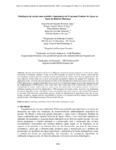Use este identificador para citar ou linkar para este item:
http://www.alice.cnptia.embrapa.br/alice/handle/doc/1010005Registro completo de metadados
| Campo DC | Valor | Idioma |
|---|---|---|
| dc.contributor.author | LIMA, J. E. F. W. | pt_BR |
| dc.contributor.author | Di SILVA, F. D. M. | pt_BR |
| dc.contributor.author | MARTINS, P. R. | pt_BR |
| dc.contributor.author | CARVALHO SOBRINHO, H. de | pt_BR |
| dc.contributor.author | OLIVEIRA, N. B. | pt_BR |
| dc.date.accessioned | 2015-02-26T11:11:11Z | pt_BR |
| dc.date.available | 2015-02-26T11:11:11Z | pt_BR |
| dc.date.created | 2015-02-26 | pt_BR |
| dc.date.issued | 2013 | pt_BR |
| dc.identifier.citation | In: SIMPÓSIO BRASILEIRO DE SENSORIAMENTO REMOTO, 16., 2013, Foz do Iguaçú. Anais... São José dos Campos: INPE, 2013. | pt_BR |
| dc.identifier.uri | http://www.alice.cnptia.embrapa.br/alice/handle/doc/1010005 | pt_BR |
| dc.description | Abstract: Payment for Environmental Services (PES) has assumed increasing importance in discussions about sustainable development strategies. Many of the PES programs are based on water erosion control and the corresponding environmental and economic benefits generated in the basins where they are implemented. The main objective of this study was to show how erosion susceptibility models can support PES programs. The application of the Universal Soil Loss Equation (USLE) in the Pipiripau River Basin was used as study case. The USLE application in a spatially distributed form proved to be an important support tool for land management and the implementation of PSE policies. The results show that a large part of the studied basin presents 'Low' susceptibility to erosion, what is great in terms of use and conservation of ecosystem services, as well as a limitation regarding the need for implantation of PES programs for erosion control. Incentives for maintaining the natural vegetation in areas with higher erosion susceptibility and conserving rural roads justify PES programs in the basin. Soil and water conservation practices should be implemented in agricultural areas, but, as they occupy, in general, regions with low susceptibility to erosion, it is expected that their impacts will be realized mainly because of the high percentage of the area under this use. | pt_BR |
| dc.language.iso | por | pt_BR |
| dc.rights | openAccess | pt_BR |
| dc.subject | Modelagem | pt_BR |
| dc.subject | Payment for Environmental Services | pt_BR |
| dc.subject | Pagamento por serviços ambientais | pt_BR |
| dc.subject | Piripau | pt_BR |
| dc.title | Modelagem da erosão como subsídio a implantação do Programa Produtor de Águas na Bacia do Ribeirão Pipiripau. | pt_BR |
| dc.type | Artigo em anais e proceedings | pt_BR |
| dc.date.updated | 2015-02-26T11:11:11Z | pt_BR |
| dc.subject.thesagro | Recurso hídrico | pt_BR |
| dc.subject.thesagro | Hidrologia | pt_BR |
| dc.subject.thesagro | Erosão | pt_BR |
| dc.subject.nalthesaurus | Water resources | pt_BR |
| dc.subject.nalthesaurus | Hydrology | pt_BR |
| dc.subject.nalthesaurus | Soil erosion | pt_BR |
| dc.subject.nalthesaurus | Models | pt_BR |
| dc.subject.nalthesaurus | Universal Soil Loss Equation | pt_BR |
| dc.format.extent2 | p. 5673-5680 | pt_BR |
| riaa.ainfo.id | 1010005 | pt_BR |
| riaa.ainfo.lastupdate | 2015-02-26 | pt_BR |
| dc.contributor.institution | JORGE ENOCH FURQUIM WERNECK LIMA, CPAC; FELIPPE DAMIÃO MELLO DI SILVA; PEDRO RIBEIRO MARTINS; HUGO DE CARVALHO SOBRINHO; NATHÁLIA BARBOSA OLIVEIRA. | pt_BR |
| Aparece nas coleções: | Artigo em anais de congresso (CPAC)  | |
Arquivos associados a este item:
| Arquivo | Descrição | Tamanho | Formato | |
|---|---|---|---|---|
| 34448.pdf | 439,37 kB | Adobe PDF |  Visualizar/Abrir |









